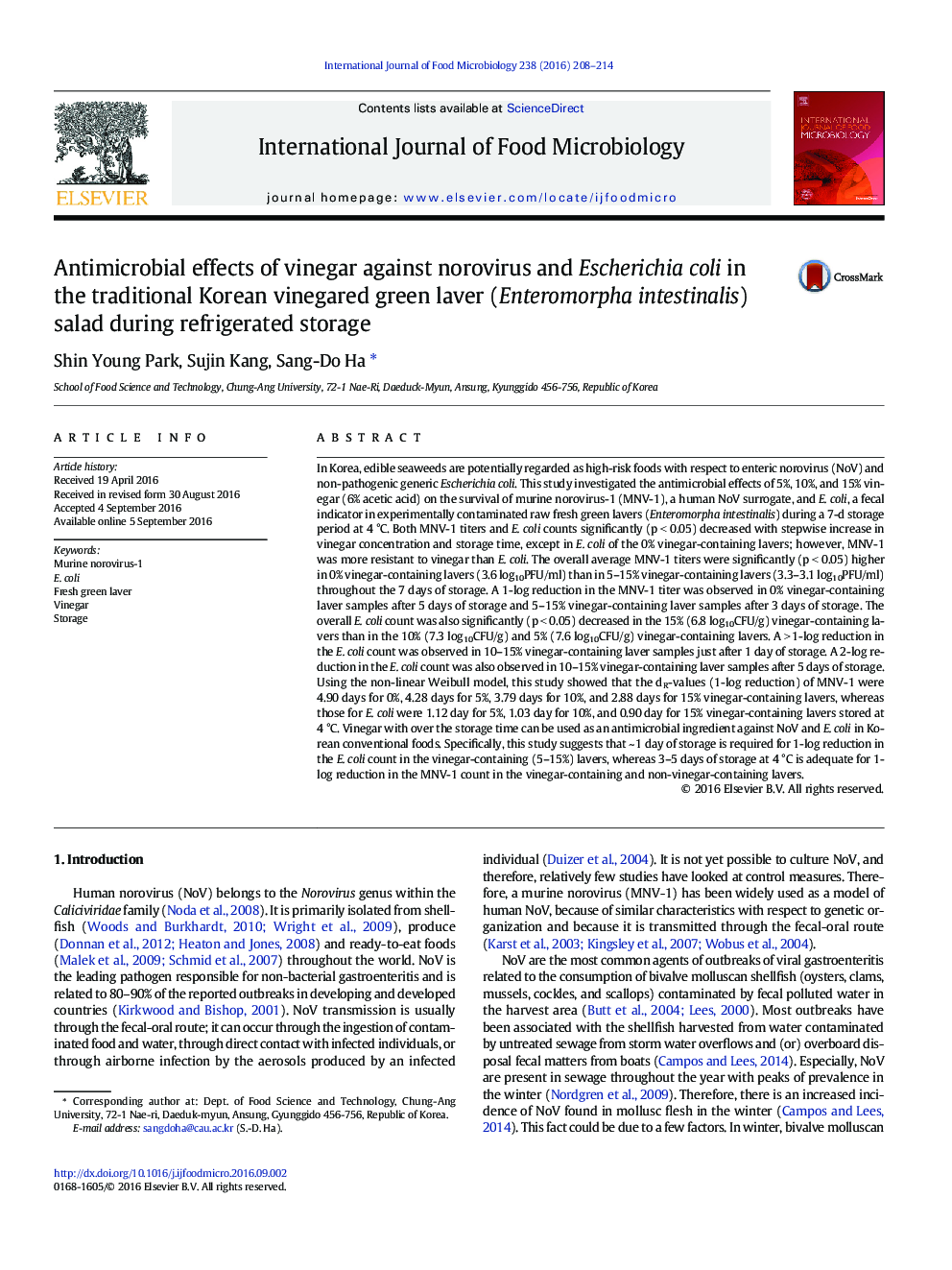| کد مقاله | کد نشریه | سال انتشار | مقاله انگلیسی | نسخه تمام متن |
|---|---|---|---|---|
| 4366135 | 1616545 | 2016 | 7 صفحه PDF | دانلود رایگان |

• Storage time of 1 log-reduction for MNV-1 and E. coli in 5% vinegar was 4.28 and 1.12 day, respectively.
• Storage time of 1 log-reduction for MNV-1 and E. coli in 10% vinegar was 3.79 and 1.03 day, respectively.
• Storage time of 1 log-reduction for MNV-1 and E. coli in 15% vinegar was 2.88 and 0.90 day, respectively.
• Vinegar with over the storage time can be used as an antimicrobial ingredient in Korean foods.
In Korea, edible seaweeds are potentially regarded as high-risk foods with respect to enteric norovirus (NoV) and non-pathogenic generic Escherichia coli. This study investigated the antimicrobial effects of 5%, 10%, and 15% vinegar (6% acetic acid) on the survival of murine norovirus-1 (MNV-1), a human NoV surrogate, and E. coli, a fecal indicator in experimentally contaminated raw fresh green lavers (Enteromorpha intestinalis) during a 7-d storage period at 4 °C. Both MNV-1 titers and E. coli counts significantly (p < 0.05) decreased with stepwise increase in vinegar concentration and storage time, except in E. coli of the 0% vinegar-containing lavers; however, MNV-1 was more resistant to vinegar than E. coli. The overall average MNV-1 titers were significantly (p < 0.05) higher in 0% vinegar-containing lavers (3.6 log10PFU/ml) than in 5–15% vinegar-containing lavers (3.3–3.1 log10PFU/ml) throughout the 7 days of storage. A 1-log reduction in the MNV-1 titer was observed in 0% vinegar-containing laver samples after 5 days of storage and 5–15% vinegar-containing laver samples after 3 days of storage. The overall E. coli count was also significantly (p < 0.05) decreased in the 15% (6.8 log10CFU/g) vinegar-containing lavers than in the 10% (7.3 log10CFU/g) and 5% (7.6 log10CFU/g) vinegar-containing lavers. A > 1-log reduction in the E. coli count was observed in 10–15% vinegar-containing laver samples just after 1 day of storage. A 2-log reduction in the E. coli count was also observed in 10–15% vinegar-containing laver samples after 5 days of storage. Using the non-linear Weibull model, this study showed that the dR-values (1-log reduction) of MNV-1 were 4.90 days for 0%, 4.28 days for 5%, 3.79 days for 10%, and 2.88 days for 15% vinegar-containing lavers, whereas those for E. coli were 1.12 day for 5%, 1.03 day for 10%, and 0.90 day for 15% vinegar-containing lavers stored at 4 °C. Vinegar with over the storage time can be used as an antimicrobial ingredient against NoV and E. coli in Korean conventional foods. Specifically, this study suggests that ~ 1 day of storage is required for 1-log reduction in the E. coli count in the vinegar-containing (5–15%) lavers, whereas 3–5 days of storage at 4 °C is adequate for 1-log reduction in the MNV-1 count in the vinegar-containing and non-vinegar-containing lavers.
Journal: International Journal of Food Microbiology - Volume 238, 5 December 2016, Pages 208–214